When monetising your game, it’s important to consider what works best for your specific game and understand how your players will feel about any rewarded offers. Missing the beat on which currencies you offer players or even the timing of when it’s offered could see a drop in user retention.
In this guest post, game design consultant at Unity, Anna Popereko, shares how to best monetise your strategy game. Anna highlights common mistakes developers make when presenting players with rewarded videos and how to combat those mistakes with better reward placements.
Every game genre is uniquely different, and with that comes many wonderful opportunities and potential pitfalls. Take strategy games for example, which are so interestingly and intricately designed, which often gets translated into an equally intricate ad monetisation strategy. But overcomplicating things can end up harming potential revenue. Keeping placements as simple as possible is more beneficial so they seamlessly fit into the gameplay and feel more natural.
Let’s review some common mistakes we see happen when monetising strategy games, and then I’ll provide recommendations for rewarded video placements that work well in this genre.
Common rewarded video mistakes to avoid
1. Offering a rare currency to all players
Segmenting your users and the rewards they get can have a huge impact on your KPIs. Offering rewarded video placements to all players is a must, but the rewards themselves should differ per segment. If your game offers rare currency, which is generally used in specific situations and is not part of the core loop, save it for advanced users who are reaching higher levels. Beginners should get the basic currency relevant to their level, making them more likely to engage with the rewarded video. This will help you engage a wider audience with your ad monetisation offering.
2. Creating an additional rewarded video currency
When it comes down to it, strategy players just want to get the resource they need, so if a rewarded video makes it easy for them to get it, they'll be more engaged. Some developers have been tempted to create an additional currency specifically for rewarded videos. But all this does is put the player further away from their main goal of obtaining the reward. Not only is the extra currency an unnecessary additional step for players, but they often forget about spending the new currency, further delaying receiving their reward.

3. Non-strategic placement of videos
A common mistake is to get tempted into scattering rewarded video ads in multiple places throughout the game. But it’s better to start small. Look at your game’s core loop and see where adding a rewarded video feels natural.
For example, if the core loop has something time-based, such as building or resource production, the rewarded video will instantly help the player, so the engagement will likely be higher. Once you meet the basic needs of your players, engagement will flow naturally, ultimately increasing revenue.

Ideal placements for rewarded video in strategy games
Once ensured that their placement plays an integral part in the game's experience and economy, rewarded videos can and should be shown many times throughout the game.
Though monetising users starts immediately, focusing efforts on players with longer retention, such as day seven and day 30 is important. As a player progresses in the game, the rewards get more valuable and therefore more useful in helping them succeed, which helps retain them in the game.
How to boost ad engagement with rewarded video placements
1. Home screen
Since strategy players spend most of their time on the home screen toggling between different actions, it’s no surprise that the home screen is a critical part of a strategy game’s rewarded video plan. Because it’s the most exposed, players will have more opportunities to engage with rewarded videos there.
Examine the core loop for what resources players constantly need to progress through the game and select those resources as rewards. Basic resources, soft currency, and gacha often fall into this bucket. Most importantly, make sure to A/B test the rewards to see which drives the most revenue and engagement.
To get more from this placement, add a timer and give players a sense of urgency. It generates a sense of missing out that encourages players to act fast, increasing engagement.
2. In-game store
Most strategy players who head to the in-game store will not actually spend money there. This is why it’s a great opportunity to offer rewarded videos in the store. Just ensure that these ads offer rewards that don’t compete with the store items yet still offer value - like treasure chests or gachas. In-store placements are an opportunity to monetise players who aren’t currently paying and can even help drive traffic to the store. Be strategic in how you achieve this. Set the pacing of the rewarded videos between 4 to 6 hours and then A/B test to find the ideal pace for the placements.
3. Time boost
The combination of the placement with the reward can influence engagement. In strategy games, for example, where the wait time increases as a player progresses through the game, the option to speed up the wait time can be a huge win. This is known as a time boost placement.
Make sure to offer a time boost that is relevant to the wait time. Cutting the time by 10 minutes would be substantial if the wait time was 20 minutes, but not if it was 3 hours. As always, A/B test the time boost against the wait time as every game will be different.
5. Daily reward multiplier
For games that have a daily reward, a rewarded video placement that multiplies the reward is a great incentive to drive up engagement. It’s especially interesting to use this placement during the early days of a player interacting with the game since it will encourage them to accumulate coins/currency that will help them progress in the game and eventually increase retention. But make sure this isn’t your only placement. Strategy players only get one shot per day to use it - meaning you can’t monetise players more than once per day.
To summarise, it’s never been more important to maximise the value of your existing players. Nailing the monetisation strategy is key, and understanding that in-app ads done right, support and don’t cannibalise, in-app purchases which can make a huge difference in the revenue and retention for strategy games.
Edited by Paige Cook






















